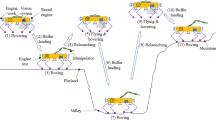Abstract
This paper deals with an effective strategy for the landing of a robot leg on uneven terrain. When the foot of the walking robot lands on uneven terrain, the actual ground contact point may be different from the reference point at every step. This may cause an early landing of the robot foot, resulting in a large landing impact force, or destabilize the robot’s balance as the foot fails to land at the planned time. To land on uneven terrain and generate a suitable vertical force to support robot weight, first, we propose a foot velocity and force transition control during the swing down and stance phases. The velocity control is used to land on the ground at various heights while reducing the landing impact, and the force control is used to support the robot’s weight after landing. The velocity control and the force control are transitioned to each other continuously based on the encoder feedback. Second, we propose a modified task-space computed torque control (CTC) to solve a coupling problem found in the conventional CTC during hybrid force/position control. Third, we propose a friction compensation method for implementing and verifying the landing strategy in real robots. The proposed friction compensation method uses the Coulomb-Viscous friction model, and the coefficients of the friction model are derived from the modified joint-space CTC with Linear Segments with Parabolic Blends (LSPB) trajectory. Finally, the landing strategy was verified through a 3-DOFs robot leg and generated the desired vertical force with a significantly small impact during landing.















Similar content being viewed by others
References
Hutter M et al (2016) ANYmal - a highly mobile and dynamic quadrupedal robot. IEEE/RSJ Int Conf Intell Robots Syst (IROS) 2016:38–44. https://doi.org/10.1109/IROS.2016.7758092
Raibert M et al (2008) BigDog, the Rough-Terrain Quadruped Robot. IFAC Proc Vol 41:10822–10825
S. Kajita et al.,(2003) "Biped walking pattern generation by using preview control of zero-moment point. In: 2003 IEEE international conference on robotics and automation (Cat. No.03CH37422), pp. 1620–1626 vol.2, doi: https://doi.org/10.1109/ROBOT.2003.1241826.
I. Park, J. Kim and J. Oh, (2006) Online Biped Walking Pattern Generation for Humanoid Robot KHR-3(KAIST Humanoid Robot - 3: HUBO). In: 2006 6th IEEE-RAS international conference on humanoid robots, pp. 398–403, doi: https://doi.org/10.1109/ICHR.2006.321303.
J. Pratt, J. Carff, S. Drakunov and A. Goswami, (2006) Capture Point: A Step toward Humanoid Push Recovery. In: 2006 6th IEEE-RAS international conference on humanoid robots, pp. 200–207, doi: https://doi.org/10.1109/ICHR.2006.321385.
Grandia R, Farshidian F, Ranftl R, Hutter M (2019) Feedback MPC for torque-controlled legged robots. IEEE/RSJ Int Conf Intell Robots Syst (IROS) 2019:4730–4737. https://doi.org/10.1109/IROS40897.2019.8968251
M. Morisawa, F. Kanehiro, K. Kaneko, S. Kajita and K. Yokoi, (2011) Reactive biped walking control for a collision of a swinging foot on uneven terrain. In: 2011 11th IEEE-RAS international conference on humanoid robots, pp. 768–773, doi: https://doi.org/10.1109/Humanoids.2011.6100885.
X. Wan, T. Urakubo and Y. Tada, (2013) Landing Motion of a Legged Robot with Impact Force Reduction and Joint Torque Minimization. In: 2013 Second international conference on robot, vision and signal processing, pp. 259–264, doi: https://doi.org/10.1109/RVSP.2013.65.
Xu W, Xiong R, Wu J (2010) Force/torque-based compliance control for humanoid robot to compensate the landing impact force. First Int Conf Network Dist Comput 2010:336–340. https://doi.org/10.1109/ICNDC.2010.72
Lynch DJ, Lynch KM, Umbanhowar PB (2020) The soft-landing problem: minimizing energy loss by a legged robot impacting yielding terrain. IEEE Robot Autom Lett 5(2):3658–3665. https://doi.org/10.1109/LRA.2020.2977260
Kim Y, Lee B, Ryu J, Kim J (2007) Landing force control for humanoid robot by time-domain passivity approach. IEEE Trans Rob 23(6):1294–1301. https://doi.org/10.1109/TRO.2007.906250
S. Min Yoo, S. Wook Hwang, D. Ha Kim and J. Hyeon Park, (2018) Biped Robot Walking on Uneven Terrain Using Impedance Control and Terrain Recognition Algorithm. In: 2018 IEEE-RAS 18th international conference on humanoid robots (humanoids), pp. 293–298, doi: https://doi.org/10.1109/HUMANOIDS.2018.8624996.
Hun-ok Lim, S. A. Setiawan and A. Takanishi, (2001) Balance and impedance control for biped humanoid robot locomotion. In: Proceedings 2001 IEEE/RSJ international conference on intelligent robots and systems. expanding the societal role of robotics in the the next millennium (Cat. No.01CH37180), pp. 494–499 vol.1, doi: https://doi.org/10.1109/IROS.2001.973405.
Siciliano B, Sciavicco L, Villani L, Oriolo G (2010) Robotics modeling planning and control. Springer, Berlin
HRRLAB, “Effective Landing Strategy of Robot Leg Using Hybrid Force/Position Control”, 13-Oct-2021. [Online Video]. Available: https://youtu.be/5D2n3yKutBQ [Accessed: 13-Oct.-2021]
Acknowledgements
This study was supported by the Research Program funded by the SeoulTech (Seoul National University of Science and Technology)
Author information
Authors and Affiliations
Corresponding author
Additional information
Publisher's Note
Springer Nature remains neutral with regard to jurisdictional claims in published maps and institutional affiliations.
Rights and permissions
Springer Nature or its licensor holds exclusive rights to this article under a publishing agreement with the author(s) or other rightsholder(s); author self-archiving of the accepted manuscript version of this article is solely governed by the terms of such publishing agreement and applicable law.
About this article
Cite this article
Kim, KH., Kim, JY. Effective landing strategy of robot leg using hybrid force/position control. Intel Serv Robotics 15, 579–592 (2022). https://doi.org/10.1007/s11370-022-00441-7
Received:
Accepted:
Published:
Issue Date:
DOI: https://doi.org/10.1007/s11370-022-00441-7



